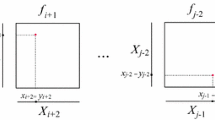Abstract
The classical validity of many important theorems of functional analysis, such as the Banach-Steinhaus theorem, the open mapping theorem and the closed graph theorem, depends on Baire’s theorem about complete metric spaces, which is an indispensable tool in this area. A form of Baire’s theorem has a constructive proof [5, Theorem 1.3], but its classical equivalent,
if a complete metric space is the union of a sequence of its subsets, then the closure of at least one set in the sequence must have nonempty interior
which is used in the standard argument to prove that the above theorems have no known constructive proof. If we could prove the Baire’s theorem of the above form, we would have the following forms of constructive versions of Banach’s inverse mapping theorem, the open mapping theorem, the closed graph theorem, the Banach-Steinhaus theorem and the Hellinger-Toeplits theorem:
-
Theorem 1 (Banach’s inverse mapping theorem)
LetT be a one-one continuous linear mapping of a separable Banach space E onto a Banach space F. Then T-1 is continuous.
-
Theorem 2 (The open mapping theorem)
Let T be a continuous linear mapping of a Banach space E onto a Banach space F such that ker(T) is located1. Then T is open.
-
Theorem 3 (The closed graph theorem)
Let T be a linear mapping of a Banach space E into a Banach space F such that graph(T) is closed and separable. Then T is continuous.
-
Theorem 4 (The Banach-Steinhaus theorem)
Let {Tm} be a sequence of continuous linear mappings from a separable Banach space E into a normed space F such that
$$ Tx: = \mathop {\lim }\limits_{m \to \infty } {T_m}x $$exists for all x ∈ E. Then T is continuous.
-
Theorem 5 (The Hellinger-Toeplitz theorem)
Let T be a linear mapping from a Banach space E into a separable normed space with the following property: if f is a normable2 linear functional f on F, and {xn} converges to 0 in E, then f (Txn) → 0. Then T is continuous.
Access this chapter
Tax calculation will be finalised at checkout
Purchases are for personal use only
Preview
Unable to display preview. Download preview PDF.
Similar content being viewed by others
References
Bishop, Errett and Douglas Bridges, Constructive Analysis, Grundlehren der math. Wissenschaften Bd. 279, Springer-Verlag, Heidelberg (1985).
Bridges, Douglas and Hajime Ishihara, Linear mappings are fairly well-behaved, Arch. Math. (Basel) 54 (1990), 558–569.
Bridges, Douglas and Hajime Ishihara, A definitive constructive open mapping theorem, MLQ Math. Log. Q. 44 (1998), 545–552.
Bridges, Douglas, Hajime Ishihara, Peter Schuster and Luminita Apartness continuity implies uniformly sequential continuity, preprint, (2001).
Bridges, Douglas and Fred Richman, Varieties of Constructive Mathematics, London Math. Soc. Lecture Notes 97, Cambridge Univ. Press, London (1987).
Ishihara, Hajime, Continuity and nondiscontinuity in constructive mathematics, J. Symbolic Logic 56 (1991), 1349–1354.
Ishihara, Hajime, Continuity properties in constructive mathematics, J. Symbolic Logic 57 (1992), 557–565.
Ishihara, Hajime, Markov’s principle, Church’s thesis and Linde15f’s theorem Indag. Math. (N.S.) 4 (1993), 321–325.
Ishihara, Hajime, A constructive version of Banach’s inverse mapping theorem, New Zealnad J. Math. 23 (1994), 71–75.
Ishihara, Hajime, Sequential continuity of linear mappings in constructive mathematics, J. UCS 3 (1997), 1250–1254.
Troelstra, Anne S. and Dirk van Dalen, Constructivism in Mathematics, Vol. 1–2, North-Holland, Amsterdam (1988).
Author information
Authors and Affiliations
Editor information
Editors and Affiliations
Rights and permissions
Copyright information
© 2001 Springer-Verlag London Limited
About this paper
Cite this paper
Ishihara, H. (2001). Sequentially Continuity in Constructive Mathematics. In: Calude, C.S., Dinneen, M.J., Sburlan, S. (eds) Combinatorics, Computability and Logic. Discrete Mathematics and Theoretical Computer Science. Springer, London. https://doi.org/10.1007/978-1-4471-0717-0_2
Download citation
DOI: https://doi.org/10.1007/978-1-4471-0717-0_2
Publisher Name: Springer, London
Print ISBN: 978-1-85233-526-7
Online ISBN: 978-1-4471-0717-0
eBook Packages: Springer Book Archive




